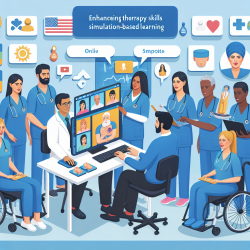The COVID-19 pandemic has revolutionized many aspects of life, including the way therapy is delivered to children. With the sudden shift to telehealth, clinicians have had to adapt quickly to provide care in a virtual environment. This transition has brought both challenges and opportunities, particularly in maintaining the playful engagement that is crucial for effective therapy with children.
The Role of Imagination and Play in Teletherapy
Lynn Borenstein highlights the importance of imagination and play in teletherapy for children. During the pandemic, many young patients faced intense feelings of isolation and learning challenges. Traditional therapy settings with toys and physical interaction were replaced by screens and virtual connections. Despite these limitations, clinicians have found ways to engage children's imaginations, fostering a sense of agency and reducing feelings of isolation.
In teletherapy, the therapist's empathy and ability to imagine the child's experiences play a vital role. By sharing in the child's imaginative world, therapists can create a joining that mitigates emotional hurdles. This approach allows for spontaneity and forward movement even in a virtual setting.
Challenges of Telehealth for Children
The shift to telehealth has not been without its critics. Studies have shown that many children struggle with communication and attention in this medium. The lack of physical presence can lead to a diminished sense of connection. Additionally, the absence of body language and facial expressions poses challenges for psychodynamic practitioners managing transference issues.
Despite these hurdles, telehealth offers unique opportunities. It allows therapists to enter the child's home environment, providing insights into their world that might not be visible in a traditional office setting. This access can enrich the therapeutic process if approached with creativity and openness to imaginative play.
Mobilizing Imaginative Play
To effectively harness imagination in teletherapy, several key elements are crucial:
- Empathic Alertness: Therapists must be attentive to the child's experience, imagining their feelings of isolation or frustration.
- Encouraging Physical Movement: Finding ways to accommodate a child's need for movement helps maintain engagement.
- Facilitating Imaginative Play: Therapists should encourage imaginative play by using their own creativity to engage with the child's world.
Case studies illustrate how therapists have successfully used these elements to transform teletherapy sessions into spaces where children feel empowered and engaged. For example, allowing a child to take control of the virtual session by "hosting" it can boost their sense of agency and creativity.
The Path Forward
The ongoing challenges of telehealth require continuous adaptation from clinicians. While Zoom fatigue is real for both patients and therapists, it also serves as a reminder to rethink clinical approaches and embrace imaginative play as a bridge to connection. Active engagement with children's imaginative worlds is essential for fostering emotional resilience and growth.
For more information on this topic, please follow this link.










